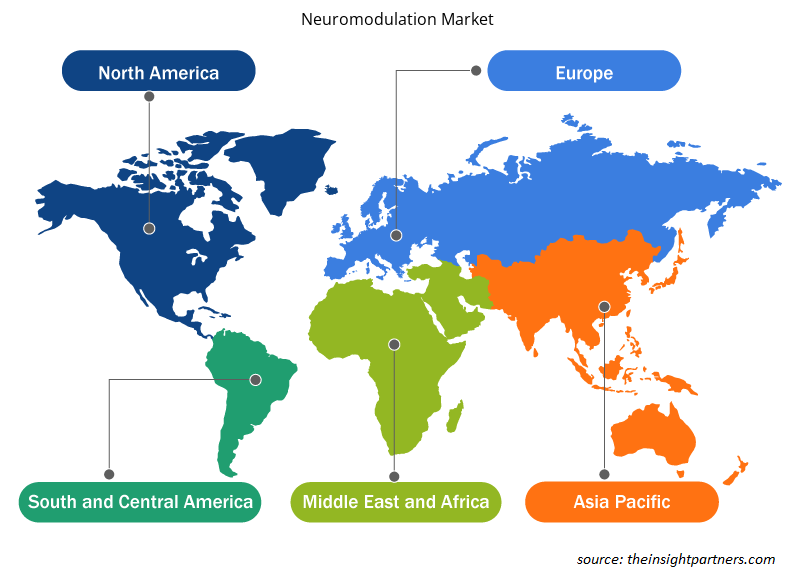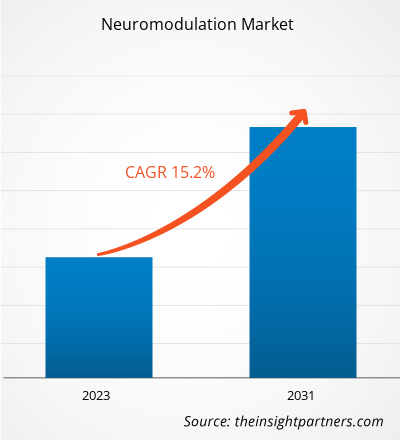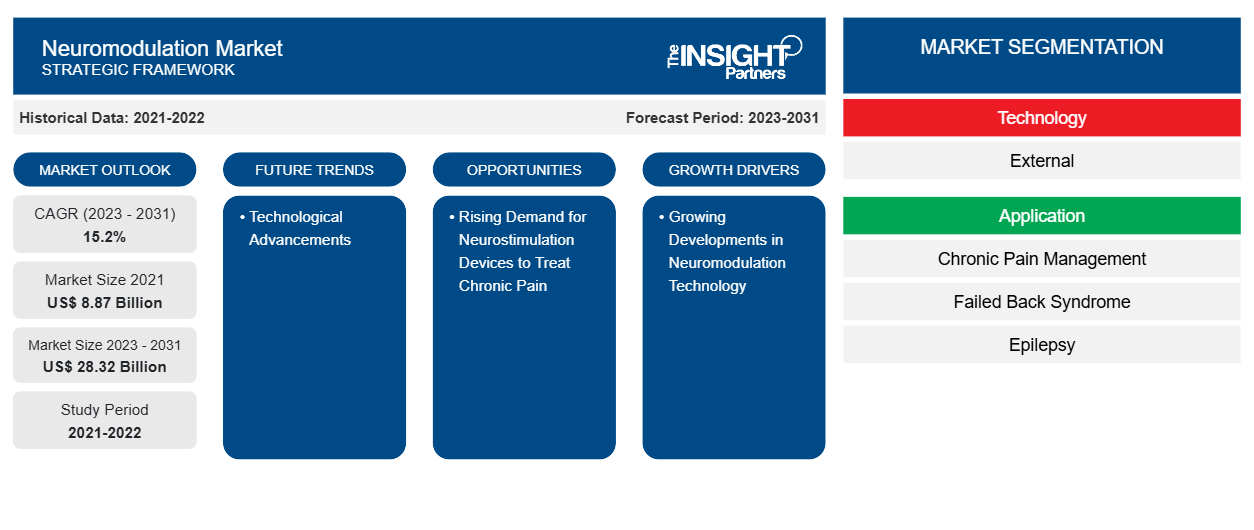Der Markt für Neuromodulation wird auf 8,87 Milliarden US-Dollar im Jahr 2021 und XX Milliarden US-Dollar im Jahr 2023 geschätzt und soll bis 2031 28,32 Milliarden US-Dollar erreichen; für den Zeitraum 2023–2031 wird eine durchschnittliche jährliche Wachstumsrate (CAGR) von 15,2 % erwartet. Die zunehmende Häufigkeit neurologischer Erkrankungen und die zunehmende Entwicklung der Neuromodulationstechnologie sind treibende Faktoren. Technologische Fortschritte werden wahrscheinlich weiterhin die wichtigsten Trends auf dem Markt für Neuromodulation bleiben.Neuromodulation market size was estimated to be US$ 8.87 billion in 2021 and US$ XX billion in 2023 and is expected to reach US$ 28.32 billion by 2031; it is estimated to record a CAGR of 15.2% in 2023–2031. The increasing incidence of neurological disorders and growing developments in neuromodulation technology are driving factors. Technological advancements will likely remain key neuromodulation market trends.
Neuromodulation Marktanalyse
Neuromodulationsgeräte enthalten kleine Elektroden am Rückenmark, Gehirn oder an peripheren Nerven. Neurologische Erkrankungen wie zerebrovaskuläre Erkrankungen, Parkinson und Alzheimer beeinträchtigen die neurologischen Funktionen des Körpers und können daher mithilfe der Neuromodulation geheilt werden. Darüber hinaus gibt es bei Medizintechnikunternehmen zunehmend Entwicklungen im Bereich der Neuromodulation und zunehmend Schulungsprogramme zur Behandlung neurologischer Erkrankungen . So wurde beispielsweise im Dezember 2023 am AIIMS ein Schulungsprogramm zu Neuromodulationstechniken in der psychischen Gesundheit des Centre for Advanced Research and Excellence in Neuromodulation für medizinisches Fachpersonal gestartet.
Marktübersicht zur Neuromodulation
Nordamerika ist der größte Markt für Neuromodulation. Das Wachstum wird vor allem durch das Auftreten neurologischer Erkrankungen wie Parkinson, Epilepsie, Alzheimer und Depressionen vorangetrieben. Laut CDC beispielsweise verdoppelt sich die Zahl der Menschen, die mit Alzheimer leben, alle fünf Jahre ab dem 65. Lebensjahr, und bis 2060 wird sich diese Zahl voraussichtlich auf 14 Millionen Menschen verdreifachen. Unter allen ethnischen Gruppen sind Frauen im Vergleich zu Männern fast doppelt so häufig von Alzheimer betroffen. Darüber hinaus bleibt Alzheimer unter Amerikanern im Alter von 65 Jahren und älter die fünfthäufigste Todesursache, weshalb die Todesfälle durch Schlaganfall, Herzkrankheiten und HIV zwischen 2000 und 2019 um mehr als 145 % gestiegen sind.
Passen Sie diesen Bericht Ihren Anforderungen an
Sie erhalten kostenlos individuelle Anpassungen an jedem Bericht, einschließlich Teilen dieses Berichts oder einer Analyse auf Länderebene, eines Excel-Datenpakets sowie tolle Angebote und Rabatte für Start-ups und Universitäten.
- Holen Sie sich die wichtigsten Markttrends aus diesem Bericht.Dieses KOSTENLOSE Beispiel umfasst eine Datenanalyse von Markttrends bis hin zu Schätzungen und Prognosen.
Treiber und Chancen auf dem Neuromodulationsmarkt
Wachsende Entwicklungen in der Neuromodulationstechnologie
Neuromodulatoren verändern die Nervenaktivität, indem sie elektrische oder pharmazeutische Wirkstoffe präzise an die Zielstelle abgeben. Sie werden immer wieder zur Linderung chronischer Schmerzen eingesetzt und ihre Anwendungsmöglichkeiten sind durch die wachsende Technologie gewachsen. So brachte CVRx im November 2022 ein neues Neuromodulationsgerät zur Behandlung von Herzinsuffizienz auf den Markt. Dieses Neuromodulationsgerät behandelt die Symptome von Herzinsuffizienz, einen neuen implantierbaren Pulsgenerator (IPG) Barostim NEO2. Diese zweite Generation reduziert die Größe des IPG um 10 % und verlängert die Batterielebensdauer um 20 %, wodurch die Häufigkeit des Geräteaustauschs für Patienten und ihre Anbieter reduziert wird. Darüber hinaus gab Medtronic im April 2021 die FDA-Zulassung für eine IDE-Studie (Investigational Device Exemption) bekannt, um sein intern entwickeltes implantierbares tibiales Neuromodulationsgerät (TNM) zu testen, eine Therapie zur Linderung der Symptome von Blaseninkontinenz. alter nerve activity by precisely delivering electrical or pharmaceutical agents at the target site. These are repeatedly used for chronic pain relief and growing technological has increased its applications. For instance, in November 2022, CVRx launched a new neuromodulation device to treat heart failure. This neuromodulation device treats the symptoms of heart failure, a new Barostim NEO2 implantable pulse generator (IPG). This second-generation reduces the size of the IPG by 10% and widens battery life by 20%, thus reducing the device frequency replacements for patients and their providers. Furthermore, in April 2021, Medtronic announced the FDA approval to proceed with an investigational device exemption (IDE) trial to gauge its internally developed implantable tibial neuromodulation (TNM) device, a therapy intended to deliver relief from symptoms of bladder incontinence.
Steigende Nachfrage nach Neurostimulationsgeräten zur Behandlung chronischer Schmerzen – eine ChanceNeurostimulation Devices to Treat Chronic Pain – An Opportunity
Die Nachfrage nach Schmerztherapiegeräten steigt bei älteren Menschen und Menschen mit Osteoporose, rheumatoider Arthritis und anderen Erkrankungen dieser Art. Laut NCBI-Forschung leiden in Indien fast 61 Millionen Menschen an Osteoporose, davon sind 80 % Frauen. Die höchste Inzidenz von Osteoporose tritt in Indien 10–20 Jahre früher auf als in westlichen Ländern. Bei solchen Erkrankungen sind Neurostimulationsgeräte zur Schmerzbehandlung erforderlich.NCBI research states that in India, almost 61 million people have osteoporosis and out of these, 80% are women. The peak incidence of osteoporosis in India occurs 10–20 years earlier than in Western countries. Such diseases are demanding neurostimulation devices to treat pain.
Darüber hinaus entwickeln mehrere Start-ups Geräte, die sich vor allem auf die Neurostimulationstherapie konzentrieren. Während der Therapie stimulieren diese Geräte das Rückenmark , das Spinalganglion und das Gehirn elektrisch, was zur Muskelentspannung und Schmerzlinderung beiträgt. Die Vorteile der Neurostimulationstherapie haben also die Entwicklung verbesserter Produkte auf dem Neuromodulationsmarkt gefördert.neurostimulation therapy. During the therapy, these devices deliver electrical stimulation to the neurostimulation therapy have encouraged the development of enhanced products in the neuromodulation market.
Die Nutzung von Neuromodulationsgeräten hat in verschiedenen nordamerikanischen, europäischen und asiatischen Ländern deutlich zugenommen.
Segmentierungsanalyse des Neuromodulationsmarktberichts
Wichtige Segmente, die zur Ableitung der Neuromodulationsmarktanalyse beigetragen haben, sind Technologie, Anwendung und Vertriebskanäle.
- Basierend auf der Technologie ist der Markt für Neuromodulation in externe (nicht-invasive) Neuromodulation und interne Neuromodulation unterteilt. Externe Neuromodulation wird weiter unterteilt in elektrische Atemstimulation (RES), transkutane elektrische Nervenstimulation (TENS) und transkranielle Magnetstimulation (TMS). Darüber hinaus ist das Segment der internen Neuromodulation auch unterteilt in Tiefe Hirnstimulation (DBS), Sakralnervstimulation (SNS), elektrische Magenstimulation (GES), Rückenmarkstimulation (SCS) und Vagusnervstimulation (VNS). Das Segment der internen Neuromodulation hatte 2023 einen größeren Marktanteil.
- Basierend auf der Anwendung ist der Neuromodulationsmarkt in Depression, Dystonie, chronische Schmerzbehandlung, Failed-Back-Syndrom, Parkinson-Krankheit, Epilepsie, Tremor, Inkontinenz, Gastroparese, Zwangsstörung (OCD) und Migräne unterteilt. Das Segment der chronischen Schmerzbehandlung hatte im Jahr 2023 einen größeren Marktanteil.
- Basierend auf dem Endverbraucher ist der Neuromodulationsmarkt in Krankenhäuser, Kliniken und häusliche Pflege unterteilt. Das Krankenhaussegment hatte im Jahr 2023 einen größeren Marktanteil.
Neuromodulation Marktanteilsanalyse nach Geografie
Der geografische Umfang des Marktberichts zur Neuromodulation ist hauptsächlich in fünf Regionen unterteilt: Nordamerika, Asien-Pazifik, Europa, Naher Osten und Afrika sowie Südamerika/Süd- und Mittelamerika.
Nordamerika dominiert den Markt für Neuromodulation. Das Wachstum des Marktes ist auf die zunehmende Entwicklung im Bereich der Medizingeräte für Neuromodulation, die steigende Zahl neurologischer Erkrankungen und die steigende Nachfrage nach Neuromodulationsgeräten zur Behandlung chronischer Schmerzen zurückzuführen. Darüber hinaus nimmt die wirtschaftliche Belastung durch die Behandlung neurologischer Erkrankungen im Land erheblich zu. Der asiatisch-pazifische Raum wird in den kommenden Jahren voraussichtlich die höchste durchschnittliche jährliche Wachstumsrate aufweisen.
Regionale Einblicke in den Neuromodulationsmarkt
Die regionalen Trends und Faktoren, die den Neuromodulationsmarkt im Prognosezeitraum beeinflussen, wurden von den Analysten von Insight Partners ausführlich erläutert. In diesem Abschnitt werden auch die Marktsegmente und die Geografie des Neuromodulationsmarkts in Nordamerika, Europa, im asiatisch-pazifischen Raum, im Nahen Osten und Afrika sowie in Süd- und Mittelamerika erörtert.

- Erhalten Sie regionale Daten zum Neuromodulationsmarkt
Umfang des Marktberichts zur Neuromodulation
| Berichtsattribut | Details |
|---|---|
| Marktgröße im Jahr 2021 | 8,87 Milliarden US-Dollar |
| Marktgröße bis 2031 | 28,32 Milliarden US-Dollar |
| Globale CAGR (2023 - 2031) | 15,2 % |
| Historische Daten | 2021-2022 |
| Prognosezeitraum | 2023–2031 |
| Abgedeckte Segmente | Nach Technologie
|
| Abgedeckte Regionen und Länder | Nordamerika
|
| Marktführer und wichtige Unternehmensprofile |
|
Marktteilnehmerdichte: Der Einfluss auf die Geschäftsdynamik
Der Markt für Neuromodulation wächst rasant, angetrieben durch die steigende Nachfrage der Endnutzer aufgrund von Faktoren wie sich entwickelnden Verbraucherpräferenzen, technologischen Fortschritten und einem größeren Bewusstsein für die Vorteile des Produkts. Mit steigender Nachfrage erweitern Unternehmen ihr Angebot, entwickeln Innovationen, um die Bedürfnisse der Verbraucher zu erfüllen, und nutzen neue Trends, was das Marktwachstum weiter ankurbelt.
Die Marktteilnehmerdichte bezieht sich auf die Verteilung von Firmen oder Unternehmen, die in einem bestimmten Markt oder einer bestimmten Branche tätig sind. Sie gibt an, wie viele Wettbewerber (Marktteilnehmer) in einem bestimmten Marktraum im Verhältnis zu seiner Größe oder seinem gesamten Marktwert präsent sind.
Die wichtigsten auf dem Neuromodulationsmarkt tätigen Unternehmen sind:
- Abbott,
- Boston Scientific Corporation,
- Medtronic,
- NeuroPace, Inc.,
- NeuroSigma, Inc.,
- NEVRO CORP.,
Haftungsausschluss : Die oben aufgeführten Unternehmen sind nicht in einer bestimmten Reihenfolge aufgeführt.

- Überblick über die wichtigsten Akteure auf dem Neuromodulationsmarkt
Neuigkeiten und aktuelle Entwicklungen zum Neuromodulationsmarkt
Der Markt für Neuromodulation wird durch die Erhebung qualitativer und quantitativer Daten aus Primär- und Sekundärforschung bewertet, die wichtige Unternehmenspublikationen, Verbandsdaten und Datenbanken umfasst. Im Folgenden finden Sie eine Liste der Entwicklungen auf dem Markt für Neuromodulation:
- Die US-amerikanische Food and Drug Administration (FDA) hat das Eterna-Rückenmarkstimulationssystem (SCS) von Abbott zur Behandlung chronischer Schmerzen zugelassen. Dieses Gerät bietet ein verbessertes Erlebnis mit der Möglichkeit, nur fünf Mal pro Jahr drahtlos aufgeladen zu werden, was den geringsten Aufladeaufwand im Vergleich zu anderen wiederaufladbaren SCS-Systemen darstellt. (Quelle: Abbott /Pressemeldung, Dezember 2022)
- GrayMatters Health, ein Entwickler digitaler Selbstneuromodulationstherapien für die psychische Gesundheitsfürsorge, gab die Markteinführung von Prism für posttraumatische Belastungsstörungen (PTBS) in den USA bekannt. Prism für PTBS ist das erste Selbstneuromodulationsgerät, das von der US-amerikanischen Food & Drug Administration (FDA) als verschreibungspflichtiges Ergänzungsmittel zur Standardbehandlung (SOC) für PTBS zugelassen wurde und in zwei US-Kliniken erhältlich ist. (Quelle: GrayMatters Health, Pressemitteilung, Januar 2024)
Marktbericht zur Neuromodulation – Umfang und Ergebnisse
Der Bericht „Neuromodulationsmarktgröße und -prognose (2021–2031)“ bietet eine detaillierte Analyse des Marktes, die die folgenden Bereiche abdeckt:
- Marktgröße und Prognose auf globaler, regionaler und Länderebene für alle wichtigen Marktsegmente, die im Rahmen des Projekts abgedeckt sind
- Marktdynamik wie Treiber, Beschränkungen und wichtige Chancen
- Wichtige Zukunftstrends
- Detaillierte PEST/Porters Five Forces- und SWOT-Analyse
- Globale und regionale Marktanalyse mit wichtigen Markttrends, wichtigen Akteuren, Vorschriften und aktuellen Marktentwicklungen
- Branchenlandschaft und Wettbewerbsanalyse, einschließlich Marktkonzentration, Heatmap-Analyse, prominenten Akteuren und aktuellen Entwicklungen
- Detaillierte Firmenprofile
- Historische Analyse (2 Jahre), Basisjahr, Prognose (7 Jahre) mit CAGR
- PEST- und SWOT-Analyse
- Marktgröße Wert/Volumen – Global, Regional, Land
- Branchen- und Wettbewerbslandschaft
- Excel-Datensatz
Aktuelle Berichte
Erfahrungsberichte
Grund zum Kauf
- Fundierte Entscheidungsfindung
- Marktdynamik verstehen
- Wettbewerbsanalyse
- Kundeneinblicke
- Marktprognosen
- Risikominimierung
- Strategische Planung
- Investitionsbegründung
- Identifizierung neuer Märkte
- Verbesserung von Marketingstrategien
- Steigerung der Betriebseffizienz
- Anpassung an regulatorische Trends





















 Kostenlose Probe anfordern für - Markt für Neuromodulation
Kostenlose Probe anfordern für - Markt für Neuromodulation